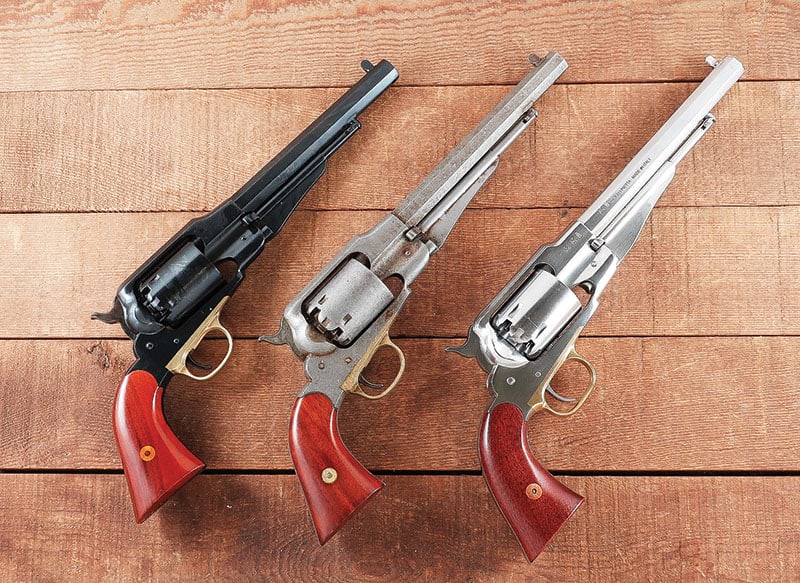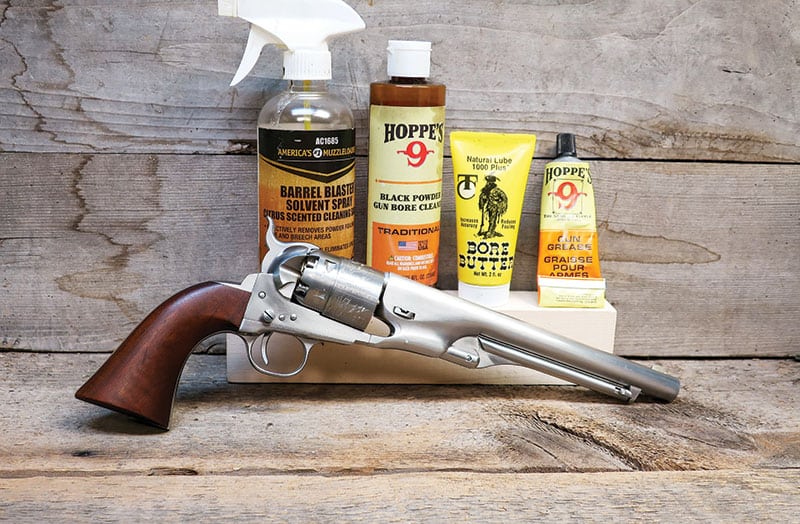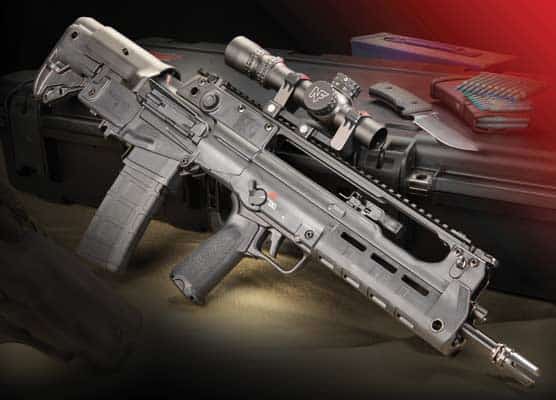Loading For Percussion
Sixguns Part 2
.44s With Round Balls
By 1851, Colt had three basic sixguns to offer. At the most powerful end of the spectrum was the .44 Dragoon while at the other end we find the most popular of all the Colt percussion sixguns, the .31 Pocket Models. In between was the easy-to-carry .36 Navy. Something was still missing.
The Missing Link Arrives
To fill in this blank in 1860, just before the outbreak of the War Between the States, Colt came out with what many consider the finest of all the cap-and-ball sixguns. Improved metallurgy allowed Colt to almost place the power of the Dragoon in a sixgun the size of the 1851 Navy. Colt engineers went to work and the result was the Colt 1860 Army .44.
To make this work, Colt took the basic Navy frame, cut a step in the water table and matched it up with a rebated cylinder larger at the front to be able to hold a full 40 grains of black powder under a .44 caliber ball. Barrel length was 8″.
The 1860 Army was powerful, well balanced and a natural pointer. It also carried the best grip shape for handling heavy loads until the advent of the Freedom Arms five-shot revolver and the Ruger Bisley. I have replaced standard single action grip frames on several replicas Single Action Armies with 1860 Army grip frames; however, I have also gone the other way and put a Navy Grip frame on an 1860 Army .44 as the original 1851 Navy grip shape is a more natural pointer for me. The 1860 Army was extremely popular with both the military and civilian population during the Civil War with the United States Army ordering 130,000 of the pistols at $17.69 apiece. This would be the last full-sized, big-bore, percussion pistol offered by Colt.
Currently, the 1860 Army is produced in several versions, all having the original 8″ barrel length. I have found some of these are at their best with 0.451″ round balls while others require 0.454″ round balls. Also some prefer Remington #10 percussion caps while others are at their best with #11 from CCI. All of my 1860s have had the factory nipples replaced with stainless steel SliX Shots versions from SliX Springs. These not only work well with either of these percussion caps, they go a long way to prevent cap jams or cap “sucking” — the hammer pulling the fired cap off the nipple.
Using Goex FFFg powder in volume charges of 25, 30 or 35 grains in the 1860 Army results in muzzle velocities, respectively, right at 765 fps, 885 fps and 965 fps. The first two are used with a wad between the powder and ball; however, there is not enough room for the wad when using the heaviest charge. No matter which charge I use, I also place lube over the end of the ball at the front of the cylinder using my own recipe of 50-50 beeswax and mutton tallow, or 50-50 beeswax and vegetable oil for a softer lube.
With Pyrodex, 25 grains by volume, gives 665 fps; 30 grains, 800 fps; 35 grains, 900 fps; and 40 grains results in 930 fps. The first two are with wads and all have the lube applied from the front of the cylinder. Which lube I use normally depends upon the temperature with the latter lube used in the lower temperatures.
In addition to the standard versions of the 1860 Army and Remington New Model Army, replicas are also offered with a 5 ½” barrel. Just as with the longer barrel, these are fitted with a loading lever. During the original days of the cap and ball revolvers from about 1836 until the arrival of cartridge-firing sixguns in the late 1860s, short-barreled Perfect Packing’ Percussion Pistols are not easy to find. Certainly individual owners cut the barrels of their pistols to make them easier to carry but what about short-barreled production cap-and-ball sixguns? It is easy to say there were none; however, this is another example of never say never.
In his excellent book, Colt Model 1860 Army Revolver, a must-have for anyone interested in these wonderful percussion pistols, author Charles Pate states there were at least one each 1860 Army revolvers made with 4 ½”, 5 ½” and 6 ½” and also interestingly enough, one with a 10″ barrel. So, the idea of a pre-Buntline Special Percussion-Style is not so far-fetched and these are offered in replica form with 12″ barrels in both 1851 and 1860 Colt versions as well as the Remington New Model Army.
Cleaning Up
There are two extreme views concerning black powder. Some say black powder is messy and not worth bothering with. At the other end of the spectrum we find those traditionalists who maintain smokeless powder is just a passing fad and when all smokeless powder and cartridges are discarded, black powder will remain. Although I may be a highly opinionated and biased individual, this is one of the few things in life on which I refuse to take sides. Black powder is worth the time and effort and it really is not all hard to clean guns that fire it.
In the earlier shooting days with black powder, I raided my wife’s kitchen to find a cleaning solution to keep my percussion sixguns operating smoothly. This wonder was found in the clear plastic spray bottle marked “Windex.” Windex contains ammonia and vinegar and cuts black powder fouling right now. As a sixgun becomes sluggish in operation, I simply sprayed a little Windex at the front and back of the cylinder and run a Windex -soaked patch down the barrel. Nowadays I use what is commonly called “Moose Milk,” which is a mixture of Ballistol and water.
Black powder is highly corrosive and a sixgun should be cleaned immediately, or soon, after shooting. The importance of this varies in different parts of the country depending upon the humidity level. The higher the moisture content in the air, the quicker the corrosive action of black powder kicks in. I live in a dry climate but I still clean my sixguns the day of






